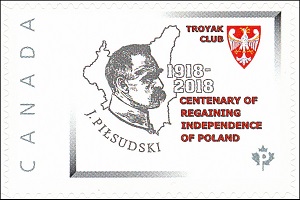

Happy 200th issue of monthly Bulletin
of the Polish-Canadian Coin and Stamp Club “Troyak”
Cheers!



TROYAK EXECUTIVE TEAM is informing all members, colleagues, collectors and Polonia at large, that Club meetings taking place at John Paul II Polish Cultural Centre, 4300 Cawthra Rd. (just south of Hwy. 403), Mississauga, Ontario. The new members are always welcome. www.polishculturalcentre.ca
ADRES SPOTKAÑ KLUBOWYCH ! Zarząd Główny Klubu “Troyak” informuje wszystkich członków kolekcjonerów, sympatyków oraz całą Polonię, że spotkania klubowe odbywają się w Polskim Centrum Kultury im. Jana Pawła II, przy 4300 Cawthra Rd. (na południe od autostrady 403), Mississauga, Ontario. Zapraszamy nowych członków do prężnego. Klubu “Troyak”. www.polishculturalcentre.ca

“TROYAK” CLUB NEXT MEETINGS …
NASTĘPNE SPOTKANIA KLUBU “TROYAK” …
26th May 2019 @ 4:30 p.m.
23rd June 2019
July & August 2019 – Summer break … Letnie wakacje …

TROYAK CLUB @ Roncesvalles Polish Festival 2019
Saturday, September 14th … Sunday, September 15th, 2019
https://polishfestival.ca www.kazimierz.org
St. Casimir’s Church
Parish Hall … 156 Roncesvalles Ave. Toronto, Ontario
Stamp Exhibit … Pope John Paul II on World Stamps and
Displays of Coins, Stamps, Collectibles by Troyak Club Members.
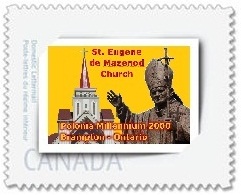
29th September 2019
6th October 2019 @ 9:00 a.m. to 4:00 p.m.
Mississauga’s Coin & Stamp Show 2019
27th October 2019; 24th November 2019

Miasta polskie – Białystok
Polish cities – Białystok
www.poczta-polska.pl
Wartość: 5 zł … autor projektu znaczka: Andrzej Gosik;
liczba znaczków: 1; nakład: 10 000 000 szt.;
technika druku: rotograwiura; format znaczka: 31,25 x 25,5 mm;
arkusz sprzedażny: 100 znaczków; papier: fluorescencyjny;
data wprowadzenia do obiegu: 19 lutego 2019 r.

A stamp printed using rotogravure, on fluorescent paper.
Size of the stamp: 31,25 x 25,5 mm. Sales sheets contains 100 pcs. of stamps.
Poczta Polska uhonorowała znaczkiem 100. rocznicę przywrócenia Białegostoku niepodległej Polsce. Białystok jest kolejnym miastem filatelistycznej serii „Miasta polskie”. Znaczek o wartości 5 zł trafił do obiegu 19 lutego br. Okazją jest 100. rocznica przejęcia miasta przez polskie wojsko w 1919 roku. Polska odzyskała niepodległość 11 listopada 1918 roku, jednak niemiecka okupacja Białegostoku zakończyła się dopiero trzy miesiące później – 19 lutego 1919 roku. Tego dnia z miasta odjechał do Prus Wschodnich ostatni pociąg z niemieckim wojskiem, a na ulicach pojawili się wkraczający do Białegostoku polscy żołnierze.
Poczta Polska w ramach emisji filatelistycznych honoruje najważniejszych polskich bohaterów i najważniejsze wydarzenia z naszej historii, ale również upamiętnia miejsca i miasta. Na wydawanym właśnie znaczku, wchodzącym w skład cyklu prezentującego polskie miasta, przedstawiono Gryfa – herb rodziny Branickich na tle Pałacu Branickich w Białymstoku. Obiekt jest uznawany za jedną z najpiękniejszych realizacji barokowej architektury w naszej części Europy. Mecenat hetmana Jana Klemensa Branickiego doprowadził w XVIII wieku do nazwania białostockiego pałacu mianem „Polskiego Wersalu”. Obecnie w Pałacu Branickich znajduje się siedziba Uniwersytetu Medycznego.
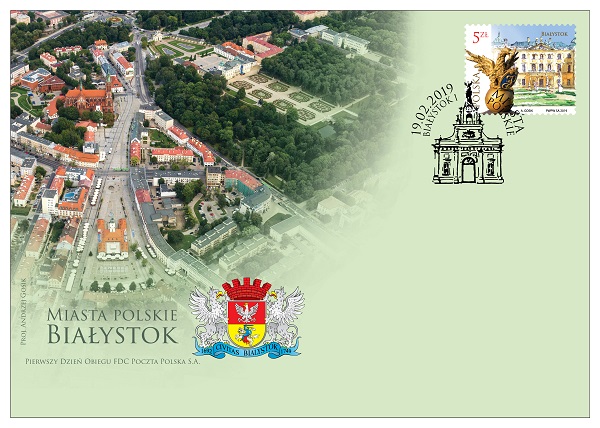
Białystok uchodzi za perłę północy. Ma bogatą historię, a ze względu na położenie w sąsiedztwie Litwy, Białorusi i Rosji stał się miejscem koegzystencji ludzi różnych kultur, wyznań i narodowości. Fakt ten ukształtował niepowtarzalny charakter Białegostoku. Oprócz znaczka Poczta Polska wyemitowała kopertę FDC (pierwszego dnia obiegu), na której została przedstawiona panorama Białegostoku. Do tej pory w ramach serii „Miasta polskie” ukazały się znaczki dedykowane m.in. Żywcowi, Sieradzowi, Szczecinowi, Przemyślowi, Warszawie, Katowicom i Lublinowi, Toruniowi i Nowemu Sączowi.

100-lecie Geografii Wojskowej
100th Anniversary of Military Geography
www.poczta-polska.pl
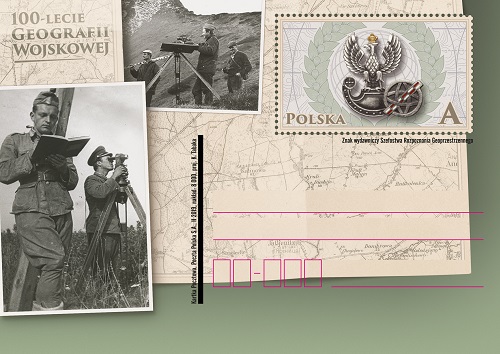
Dnia 23 lutego 2019 r. została wprowadzona do obiegu kartka pocztowa z nadrukowanym znakiem opłaty pocztowej, emisji: 100-lecie Geografii Wojskowej. Wartość nominalna znaku opłaty pocztowej z oznaczeniem literowym A odpowiada wartości nominalnej znaczka pocztowego używanego do uiszczenia opłaty za ekonomiczną przesyłkę listową nierejestrowaną, w tym kartkę pocztową, w obrocie krajowym, o masie do 350 g.
W prawym górnym rogu strony adresowej kartki nadrukowano znak opłaty pocztowej, na którym przedstawiono znak wydawniczy Szefostwa Rozpoznania Geoprzestrzennego; w prawym dolnym rogu znaczka umieszczono oznaczenie wartości: A, a w lewym dolnym rogu – napis POLSKA. W części ilustracyjnej kartki znajduje się nazwa emisji „100-lecie Geografii Wojskowej” oraz archiwalne fotografie żołnierzy pracujących w terenie podczas opracowywania map i sprawdzania fotoplanów; tłem całej kartki jest fragment mapy. Kartkę o wymiarach 148 x 105 mm wydrukowano jednostronnie, techniką offsetową, na kartonie białym, w nakładzie 8000 sztuk. Autor projektu: Karol Tabaka.

Narodowy Dzień Pamięci „Żołnierzy Wyklętych”
National Day of Remembrance of Accursed Soldiers
www.poczta-polska.pl
Wartość: 2,60 zł … autorka projektu znaczka: Marzanna Dąbrowska;
liczba znaczków: 1; nakład: 180 000 szt.; technika druku: rotograwiura;
format znaczka: 31,25 x 51 mm; arkusz sprzedażny: 12 znaczków;
papier: fluorescencyjny; data wprowadzenia do obiegu: 1 marca 2019 r.
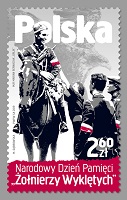
A stamp printed using rotogravure, on fluorescent paper.
Size of the stamp: 31,25 x 51 mm. Sales sheets contain 12 pcs. of stamps.
Poczta Polska upamiętnia „Orlika” na znaczku z okazji Narodowego Dnia „Żołnierzy Wyklętych” … Wizerunek mjr. Mariana Bernaciaka ps. „Orlik” znalazł się na znaczku pocztowym wyemitowanym w związku z obchodzonym 1 marca Narodowym Dniem Pamięci „Żołnierzy Wyklętych”. Poczta Polska rozpoczęła serię znaczków upamiętniających bohaterskie postawy Żołnierzy Wyklętych już w 2016 roku.
Tym razem bohaterem ze znaczka jest przedwojenny pracownik Poczty Polskiej, który podczas wojny zyskał sławę jako żołnierz kampanii wrześniowej i patriotycznego podziemia. Grafika przedstawia majora „Orlika” na koniu, kiedy wita się z mieszkańcami Ryk. Uwiecznione w ten sposób wydarzenie miało miejsce 26 lipca 1944 roku. Na tle czarno-białej kolorystyki wyróżnia się biało-czerwona opaska, jaką Marian Bernaciak ma na przedramieniu. Podobne opaski mają mieszkańcy Ryk. Autorka znaczka, Marzanna Dąbrowska umieściła na dole swego projektu napis na czerwonym tle: Narodowy Dzień Pamięci „Żołnierzy Wyklętych”. Znaczek o nominale 2,60 zł wchodzi do obiegu 1 marca 2019 r.
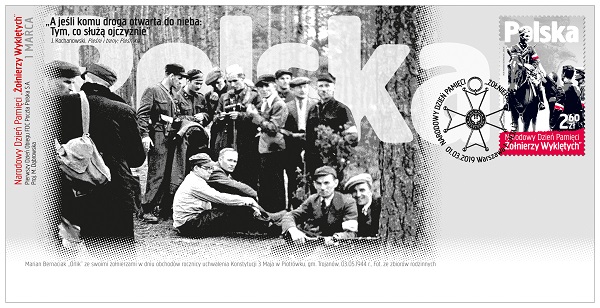
– Od kilku już lat 1. marca obchodzimy Narodowy Dzień Pamięci „Żołnierzy Wyklętych”. Udział Poczty Polskiej w tych obchodach jest zobowiązaniem wobec tych, którzy przelali krew za wolną Polskę. W tym roku upamiętniamy okolicznościowym znaczkiem majora Bernaciaka „Orlika”, który przed wojną był pocztowcem. Przyszło mu jednak żyć w czasach, kiedy o Polskę trzeba było walczyć. Specjalną emisją filatelistyczną pragniemy przywrócić pamięć o tym bohaterze, oddać hołd jego męstwu i niezłomnej postawie – mówi Wiesław Włodek, wiceprezes zarządu Poczty Polskiej. Oprócz znaczka z wizerunkiem „Orlika”, który trafi do sprzedaży w nakładzie 180 tys. sztuk, 1 marca br. do obiegu trafi również koperta FDC (pierwszego dnia obiegu).
Grafika na kopercie przedstawia mjr. Mariana Bernaciaka w gronie żołnierzy świętujących rocznicę uchwalenia Konstytucji 3 Maja w Piotrówku, gm. Trojanów 3 maja 1944 r. W 2016 roku ukazał się pierwszy znaczek emisji Narodowy Dzień Pamięci Żołnierzy Wyklętych, poświęcony mjr Zygmuntowi Szendzielarzowi „Łupaszce” (1910–1951), pośmiertnie awansowanemu do stopnia podpułkownika. Natomiast w serii „Ryngrafy Żołnierzy Wyklętych” Poczta Polska wydała w roku 2017 roku znaczki poświęcone por. Franciszkowi Majewskiemu „Słonemu” (1919–1948) i st. sierż. Mieczysławowi Dziemieszkiewiczowi „Rojowi” (1925–1951). 1 marca 2018 roku, pojawiła się emisja z rotmistrzem Witoldem Pileckim „Witoldem” (1901–1948) i Danutą Siedzikówną „Inką” (1928–1946). Poza tą serią, wydany został znaczek upamiętniający Feliksa Selmanowicza „Zagończyka” (1904–1946).

Światowe Letnie Igrzyska Olimpiad Specjalnych – Abu Dhabi 2019
Special Olympics World Games Abu Dhabi 2019
www.poczta-polska.pl
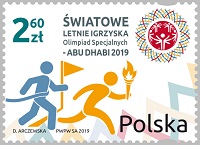
W dniu 07 marca 2019 r. został wprowadzony do obiegu znaczek pocztowy o wartości 2,60 zł emisji “Światowe Letnie Igrzyska Olimpiad Specjalnych – Abu Dhabi 2019”. Znaczek wydrukowano techniką offsetową , na papierze fluorescencyjnym, w formacie znaczka 43 x 31,25 x mm , w nakładzie 216.000 sztuk. Arkusz zawiera 12 znaczków. Na znaczku przedstawiono sylwetki: zawodnika ze zniczem olimpijskim i zawodnika przekraczającego linię mety; w górnej części znaczka umieszczono oznaczenie wartości: 2,60 zł, tytuł emisji: ŚWIATOWE LETNIE IGRZYSKA Olimpiad Specjalnych – ABU DHABI 2019 oraz logotyp igrzysk, a w prawym dolnym rogu – napis: Polska. Z tej okazji została wydana również koperta FDC. Autor projektu znaczka: Dorota Arczewska. Arkusik emisji “Światowe Letnie Igrzyska Olimpiad Specjalnych – Abu Dhabi 2019” wejdzie w skład abonamentu na arkusiki.
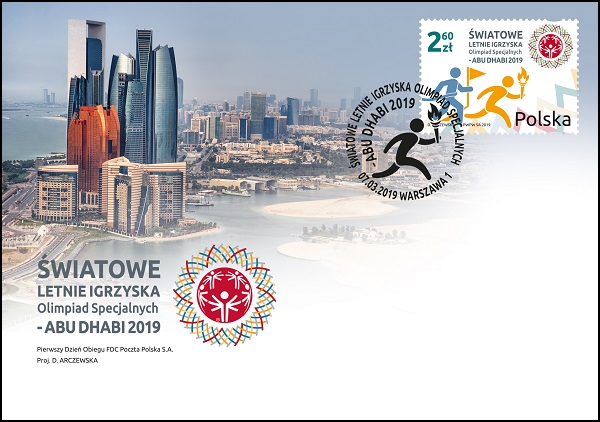
Special Olympics World Games Abu Dhabi 2019 …
denomination: 2,60 PLN; number of stamps in set: 1;
print run: 216.000 pcs.; printing techniques: offset;
paper: fluorescent; stamp size: 43 x 31,25 x mm;
12 stamps in sheet; circulation date: 7th March 2019;
number of FDC: 1; author: Dorota Arczewska.


Rejs Niepodległości – Dar Młodzieży
The Independence Sail – Dar Młodzieży
www.poczta-polska.pl
Wartość: 3,30 zł … autor projektu znaczka: Jarosław Ochendzan;
autor akwareli: Andrzej Filipowicz; liczba znaczków: 1;
nakład: 180 000 szt.; technika druku: offsetowa;
format znaczka: 40,5 x 40,5 mm; arkusz sprzedażny: 9 znaczków;
papier: fluorescencyjny; data wprowadzenia do obiegu: 28 marca 2019 r.
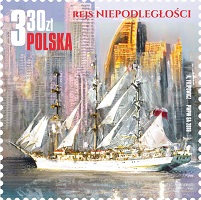
The Independence Sail – Dar Młodzieży … denomination: 3,30 PLN;
number of stamps in set: 1; print run: 180.000 pcs.;
printing techniques: offset; paper: fluorescent;
stamp size: 40,5 x 40,5 mm; 9 stamps in sheet;
circulation date: 28th March 2019; number of FDC: 1;
author: Jarosław Ochendzan, Andrzej Filipowicz.
Najpiękniejszy polski żaglowiec – „Dar Młodzieży” został przedstawiony na znaczku pocztowym. Poczta Polska upamiętniła rejs, jaki żaglowiec odbył z okazji 100. rocznicy odzyskania przez Polskę niepodległości. Znaczek o wartości 3,30 zł trafi do obiegu 28 marca br. Autorem znaczka wydanego z okazji Rejsu Niepodległości jest Jarosław Ochendzan. Na znaczku przedstawiono akwarelę autorstwa Andrzeja Filipowicza. „Dar Młodzieży” z pełnymi rozwiniętymi żaglami płynie na tle nowoczesnych wieżowców. Nakład znaczka okolicznosciowego to 180 tys. sztuk.
– 100. rocznica odzyskania przez Polskę niepodległości to wyjątkowe święto w narodowym kalendarzu. Zasługuje na szczególne upamiętnienie. Wydarzenia z listopada 1918 roku spowodowały, że Polska po 123 latach zaborów ponownie pojawiła się na mapie Europy. Mamy powody do dumy. Rejs Niepodległości, jaki odbył się pod patronatem Pana Premiera Mateusza Morawieckiego w sposób wyjątkowy miał okazję przekazywać światu wiedzę na temat naszej ojczyzny i naszej historii. Dla Poczty Polskiej obchody niepodległości są niezwykle istotne. Jesteśmy jedną z najstarszych polskich instytucji – mówi Wiesław Włodek, wiceprezes zarządu Poczty Polskiej. – Poczta Polska swoją działalnością filatelistyczną tworzy pomosty pomiędzy pokoleniami. Na naszych znaczkach swoje miejsce mają zarówno wielcy Polacy, jak też najważniejsze wydarzenia, do których niewątpliwie należy zakończony właśnie Rejs Niepodległości – podkreśla Wiesław Włodek.

W Rejsie Niepodległości dookoła świata wzięło udział blisko 1000 młodych osób z całej Polski. Odwiedzili 22 porty zlokalizowane w dziewiętnastu państwach. Byli swoistymi ambasadorami Polski we wszystkich miejscach. „Dar Młodzieży” przybił do portów Kopenhagi, Bordeaux, Dakaru, Kapsztadu, Dżakarty, Singapuru, Osaki, Los Angeles czy Londynu. Przesłaniem Rejsu Niepodległości było: „Powiedz światu, jak Polska jest piękna”. Szczególne znaczenie miał udział w Światowych Dniach Młodzieży w Panamie, którym przewodniczył Papież Franciszek. Żaglowiec wyruszył w tę niezwykłą podróż w maju 2018 roku, i powrócił do portu w Gdyni 28 marca br.

100. rocznica podpisania Dekretu o archiwach państwowych
www.nbp.pl
Narodowy Bank Polski jest centralnym bankiem państwa odpowiadającym za politykę pieniężną i stabilność cen. Jego funkcje określa Konstytucja Rzeczypospolitej Polskiej i ustawa o NBP. NBP ma wyłączne prawo emisji pieniądza. Jako bank centralny nie prowadzi rachunków bankowych obywateli, nie przyjmuje od nich lokat, nie udziela kredytów. Prowadzi natomiast obsługę budżetu państwa, a także podmiotów sektora finansów publicznych. Gromadzi rezerwy walutowe państwa i zarządza nimi. Pełni funkcję banku banków, tworząc warunki do działania systemu bankowego. Jest również jednym z najważniejszych ośrodków naukowo-analitycznych w dziedzinie ekonomii i rynków finansowych. 5 lutego 2019 roku Narodowy Bank Polski wprowadził do obiegu srebrną monetę o nominale 10 zł „100. rocznica podpisania Dekretu o archiwach państwowych”.
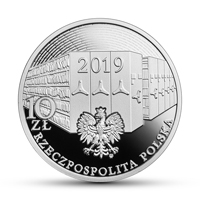

Nominał 10 zł … metal: Ag 925/1000; stempel: lustrzany;
średnica: 32,00 mm; masa: 14,14 g; brzeg (bok): gładki;
nakład: do 12 000 szt.; Projektant: Robert Kotowicz; Emitent: NBP;
Na zlecenie NBP monety wyprodukowała Mennica Polska S.A.
Na awersie monety widnieją regały kompaktowe służące do przechowywania archiwaliów oraz mikrodruk z powtarzającym się napisem ARCHIWA PAŃSTWOWE, symbolizujące zapis na nośniku cyfrowym. Na rewersie umieszczono w otoku napis 100. ROCZNICA PODPISANIA DEKRETU O ARCHIWACH PAŃSTWOWYCH. Centralną część monety wypełnia wizerunek drzewa, którego prawa część ma charakter tradycyjny, a lewa nawiązuje do świata technologii cyfrowej. Z jednej strony symbolizuje ono trwałość tradycji, osadzenie w przeszłości zapisanej w archiwaliach. Z drugiej strony stanowi odniesienie do przyszłości, do cyfryzacji zasobów. Trzydzieści trzy liście (tradycyjne i „cyfrowe”) symbolizują współczesną sieć archiwów państwowych, a centralnie umieszczony liść w koronie drzewa – Naczelną Dyrekcję Archiwów Państwowych.
W dniu 7 lutego 1919 r. Naczelnik Państwa Józef Piłsudski podpisał Dekret o organizacji archiwów państwowych i opiece nad archiwaliami. Dokument ten stanowił podstawę prawną utworzenia i funkcjonowania archiwów w odrodzonej Rzeczypospolitej. Zastąpił on Reskrypt Rady Regencyjnej w tej sprawie, wydany 31 lipca 1918 r. Dekret zawiera dziesięć rozdziałów poświęconych organizacji i zadaniom budowanej od podstaw sieci archiwów państwowych. Tworzono je w okresie bardzo trudnym dla młodego państwa, bez odpowiedniej infrastruktury technicznej i zaplecza niezbędnego do ich sprawnego działania. Przyjęty wówczas scentralizowany model kierowania był jedyną gwarancją rozwoju sieci archiwów i realizowanych przez nie zadań. Archiwa państwowe za pośrednictwem ich organu nadrzędnego, którym był Wydział Archiwów Państwowych, zostały podporządkowane Ministerstwu Wyznań Religijnych i Oświecenia Publicznego.
Do zadań WAP oraz samych archiwów państwowych należało m.in.: gromadzenie i przechowywanie zabytków rękopiśmiennych dotyczących kultury i dziejów Polski, opieka techniczna i naukowa nad zbiorami archiwalnymi, ratowanie oraz zabezpieczanie zabytków archiwalnych przed zniszczeniem, a także rewindykacja znajdujących się poza granicami kraju archiwaliów stanowiących własność państwa polskiego. Struktura organizacyjna, obejmująca archiwa w Warszawie i na obszarze całej Rzeczypospolitej, z czasem się zmieniła. Było to konsekwencją stopniowego przejmowania archiwów mających zasoby historyczne, a w 1919 r. znajdujących się jeszcze poza granicami kraju. Skutkiem działań prowadzonych na podstawie Dekretu było stworzenie zasobu archiwów państwowych, szacowanego w 1939 r. na 90 tys. metrów bieżących akt. Dokument obowiązywał do marca 1951 r. Współcześnie strukturę organizacyjną archiwów państwowych tworzy Naczelna Dyrekcja Archiwów Państwowych i 33 archiwa terenowe wraz z podległymi im jednostkami. Informacja: dr Tomasz Matuszak.

100th Anniversary of the Signing of the State Archives Decree
www.nbp.pl
Narodowy Bank Polski is the central bank of the State, responsible for its monetary policy and price stability. The Bank’s functions are described in the Constitution of the Republic of Poland and the Act on NBP. NBP holds the exclusive right to issue the currency of the Republic of Poland. As the central bank, it does not provide accounts for the general public, accept deposits from or extend loans to individuals. It acts as a banker to the State budget and public sector entities. NBP also holds and manages the foreign exchange reserves of the State. Finally, it functions as a banker to banks, creating conditions for the operation of the Polish banking system. Narodowy Bank Polski is one of the most important research and analytical centres in the fields of economics and financial markets. On 5 February 2019, Narodowy Bank Polski issued into circulation a silver coin “100th Anniversary of the Signing of the State Archives Decree”, with a face value of 10 zł.


Face value: 10 zł … Metal: Ag 925/1000; Finish: proof;
Diameter: 32.00 mm; Weight: 14.14 g; Edge (side): plain;
Mintage: up to 12,000 pcs; Designer: Robert Kotowicz; Issuer: NBP;
The coins, commissioned by NBP, were struck by Mennica Polska S.A.
The obverse of the coin features compact shelving units used for storing archival documents and microprint with the repeated inscription “STATE ARCHIVES”, symbolising storage in digital format. On the reverse, in the rim, the coin carries the inscription “100. ROCZNICA PODPISANIA DEKRETU O ARCHIWACH PAŃSTWOWYCH” [100TH ANNIVERSARY OF THE SIGNING OF THE STATE ARCHIVES DECREE]. The central part of the coin displays an image of a tree, with its right part being traditional, and its left part relating to the world of digital technology. On the one hand, the tree symbolises the continuity of tradition and rootedness in the past recorded in the archives. On the other hand, it constitutes a reference to the future, to the digitalisation of resources. The thirty-three leaves (traditional and “digital”) symbolise the contemporary network of state archives, and the centrally placed leaf in the crown of the tree – the Head Office of State Archives.
On 7 February 1919, Józef Piłsudski, Chief of State, signed the Decree on the Organisation of State Archives and the Custody of Archival Documents. The document served as a legal basis for the establishment and functioning of archives in the reborn Republic of Poland. It replaced the Regency Council Rescript on the archives, issued on 31 July 1918. The Decree contains ten chapters on the organisation and tasks of creating the state archives network created from scratch. The archives were created at a very difficult time for the young state, without proper technical infrastructure and support necessary for the archives to operate smoothly. The centralised model of management adopted at that time was the only guarantee of the development of the archives network and the tasks fulfilled by the archives.
Through their superior authority, which was the Department of State Archives, the state archives were subordinated to the Ministry of Religious Denominations and Public Enlightenment. The tasks of the Department of State Archives and the state archives themselves included, among others, the collection and storage of manuscripts related to the culture and history of Poland, technical support and scientific supervision of archival resources, preservation and protection of documentary heritage from damage, as well as reclaiming Polish state-owned archival documents located outside Poland. The organisational structure, which includes the archives in Warsaw and across the Republic of Poland, changed over time. That resulted from the gradual take-over of archives which held historical resources but were still located outside Poland in 1919. The activities are undertaken pursuant to the Decree resulted in creating collections of state archives, estimated in 1939 at 90,000 metres of records. The document applied until March 1951. Nowadays, the organisational structure of the state archives comprises the Head Office of State Archives and 33 local archives along with entities which they are in charge of. Info: Tomasz Matuszak, PhD.


Sir Frederick Banting (1891 – 1941) & Dr. Charles Best (1899 – 1978)
www.canadapost.ca https://postagestampguide.com
Sir Frederick Banting and Dr. Charles Best developed insulin treatment for diabetes in 1921. Sir Banting shared the 1923 Nobel Prize in Physiology and Medicine for the discovery of insulin.
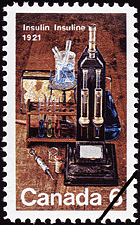
Denomination: 6¢ … Date of Issue: March 3, 1971;
Quantity: 24,200,000; Perforation or Dimension: 11;
Printer: British American Bank Note Company.
Historical Notice: … Fifty years ago, medical history was made in Canada when insulin, the hormone used in the treatment of diabetes, was isolated. millions of doomed diabetics were given the gift of life and Canada took a giant step into this century’s medical research as a result of the work of two medical scientists, Dr. Frederick G. Banting, and Dr. Charles H. Best. They laboured through the hot summer of 1921 in a laboratory of the University of Toronto Medical School to find a remedy for diabetes, a condition in which the body is unable to efficiently use sugars and other food materials. With insulin, the life expectancy of diabetics increased to near normal for most sufferers. Almost overnight the picture has changed as the death rate began to drop. Children, formerly the worst sufferers from diabetes since it was invariably fatal to them, have become the greatest beneficiaries of insulin.
In 1923, one of the co-discoverers, Dr. Banting, was awarded the Nobel Prize in Medicine, the first Nobel Prize won by a Canadian in any field. This recognition was an inspiration to Canadian medicine in that a more realistic amount of the nation’s resources was devoted to medical research. Dr. Banting perished tragically and prematurely on 21st February 1941 in the crash of an R.A.F. Ferry Command Hudson aircraft in the bleak wilds of northern Newfoundland. “He died as he lived, in the service of his country and of humanity”. The unique characteristics of this stamp prompted the following comments from members of the Canada Post Office Design Advisory Committee: We recognized an immediate difficulty in trying to find a design to commemorate the discovery of something that in itself could not be illustrated. One possibility which occurred to us was a drawing or photograph of the original laboratory in which Banting and Best worked and which is now preserved at the Ontario Science Centre. We turned to Mr. Ray Webber as a man who is particularly able to give life to inanimate objects and he certainly surpassed our expectations. In this photograph, which we believe is a first in stamp design, Webber has taken actual instruments and materials used by Banting and Best to create a still life of charm and beauty. It contains moreover, a feeling about the human act of discovery and it puts the viewer in direct touch with the minds and the hands of the scientists themselves. (41-V-19)


Queen: PermanentTM Domestic stamps – Booklet of 10
www.canadapost.ca
Pay tribute to Her Majesty Queen Elizabeth II and her famous Canadian Maple Leaf brooch with this booklet of 10 PermanentTM domestic stamps. The Queen has graced more than 70 Canadian stamps. On the back of the booklet, in a photo taken during the 2010 Canadian Royal Tour, the Queen is shown wearing her iconic Maple Leaf brooch. King George VI gave the brooch to the Queen Mother in 1939, to mark the couple’s first Canadian Royal Tour. Queen Elizabeth II (then Princess Elizabeth) later wore it during her first Canadian Royal Tour in 1951. The tradition of wearing the brooch on a first royal tour of Canada has continued through generations with the Duchess of Cornwall doing so in 2009, followed by the Duchess of Cambridge in 2011.
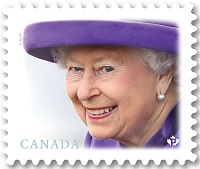
Stamp value: PermanentTM (domestic rate) …
Issue date: January 14, 2019; Stamp Designer: Steven Slipp;
Dimensions: 20.25 mm x 23.5 mm;
Quantity produced: Continuous printing.

Queen: Official First Day Cover … On the front is an image of the magnificent brooch, and a domestic stamp featuring Her Majesty. The stamp is cancelled in Ottawa, Ontario, with a maple leaf image reminiscent of the brooch. On the reverse is a portrait of Her Majesty wearing the iconic brooch to mark Canada’s 150th anniversary in 2017. King George VI gave the iconic brooch to the Queen Mother in 1939 to mark the couple’s first Canadian Royal Tour. Queen Elizabeth II (then Princess Elizabeth) later wore it during her first Canadian Royal Tour in 1951. The tradition of wearing the brooch on a first royal tour of Canada has continued through generations with the Duchess of Cornwall doing so in 2009, followed by the Duchess of Cambridge in 2011. The Queen graced her first Canadian stamp in 1953 and has since appeared on more than 70 Canada Post stamps. Quantity produced: 7,000; Dimensions: 190 mm x 112 mm; Cancellation site: Ottawa, ON.

2019 … 5 oz. Pure Silver Coin – Symbolic Canada
www.canadapost.ca www.mint.ca
From culture to geography, Canada is a country defined by diversity. And nowhere is that diversity is more evident than in the different icons that represent Canada. Our challenge with this 5 oz. coin was to represent Canada in a symbolic design that highlights what makes us unique. But with so many icons to choose from, we couldn’t pick just one. Instead, we’ve combined several famous Canadian symbols to form a single image that radiates pride. On the reverse, each stylized icon tells a story—from the canoe to the evergreens, the North Star and the inunnguaq, and even the rocks that represent each province and territory. Coming together as one, they give shape to a nation’s spirit, a shape that resembles the most famous Canadian icon of all: the maple leaf.

Face value: 50 dollars … Composition: 99.99% pure silver;
Mintage: 750; Finish: proof; Weight: 157.6 g;
Diameter: 65.25 mm; Edge: serrated; Certificate: serialized;
Artist: Adam Young (reverse), Susanna Blunt (obverse).
Design: Designed by Canadian artist Adam Young, your coin features a composition of pride-evoking icons that represent Canada in many different ways. From top to bottom, each of the 13 layers of stone symbolizes a Canadian province or territory. Water wraps around this rock formation to connect each coast, where the pine trees represent a natural resource that has provided much revenue and inspired many works of Canadian art. The canoe pays homage to the First Peoples of Canada, while reflecting on the way many Canadians originally arrived to these shores. At the top of it all, the inunnguaq symbolizes Canada’s spirit, strength, and determination; its legs form a window that frames the North Star, which radiates like a lighthouse beacon that provides safety, guidance and a luminous welcome to these shores. The composition intentionally mimics the shape of a maple leaf, including the paddle that forms the leaf’s petiole. The obverse features the effigy of Her Majesty Queen Elizabeth II by Susanna Blunt.


2019 … $200 Pure Gold Coin – 100th Anniversary of CN
www.canadapost.ca www.mint.ca
Celebrate 100 years of railway history with a premium tribute piece. Its locomotives were the driving engines of development; its tracks, the ribbons of steel that are woven into the fabric of a nation. Incorporated in 1919, the Canadian National Railway Company (CN) has left its imprint on a modern Canada—from transportation and broadcasting to telecommunications, and even aviation. This 99.99% pure gold coin traces 100 years of rail history that are synonymous with a century of progress. East and west, past and present are all connected on the reverse, where three locomotives (Nos. 6060, 6400 and 2304) and a stylized map are framed by the tracks that have kept Canada moving since the Age of Steam.
Superbly crafted. The precision-engraved reverse features an outstanding amount of fine details that will inspire pride and awe—for the history represented in this collector-friendly design, and for the locomotives that fascinate rail enthusiasts of all ages. Designed to please. The finely engraved reverse features a powerful, train-themed design that has a classic look and feels to it. A modern twist on a classic feature. Instead of denticles, the reverse is framed by train tracks—a nod to coins issued during the Age of Steam.

Face value: 25 dollars … Composition: 99.99% pure gold;
Finish: Proof; Weight: 15.43 g; Diameter: 29 mm;
Mintage: 1,000; Artist: Tony Bianco.
Its locomotives were the driving engines of development, while its tracks are the ribbons of steel that are woven into the fabric of a nation. Since its incorporation in 1919, the Canadian National Railway Company (CN) has left its imprint on a modern Canada. The freight trains of today are the continuation of a storied railway tradition. And it began in the Age of Steam, when CN’s network-connected Canadians from the Atlantic to the Pacific, and supported the communities in between. From transportation to telecommunications, CN’s 100-year history is synonymous with a century of progress in Canada. To commemorate CN’s centennial year, this 99.99% pure gold coin features a classic railway design on its reverse. The different locomotives are a tribute to a century of driving innovation, framed by the tracks that continue to be the backbone of our economy.
Design: Designed by Tony Bianco, your coin features a side-by-side view of three Canadian National Railway (CN) engines that have powered progress in Canada during the last 100 years. On the far right is No. 6060, one of the last Mountain steam locomotives delivered to CN. Next is Locomotive 6400, a class U-4-a Confederation steam locomotive that was used for the Royal Visit in 1939. In the foreground, CN 2304 is a GE ES44DC model that represents today’s efficient diesel freight locomotives. Instead of denticles, train tracks circle the rim and frame a stylized map that alludes to the railway’s impact across Canada. The reverse includes the face value “200 DOLLARS”, the commemorative dates “1919” and “2019”, and the word “CANADA”. The obverse features the effigy of Her Majesty Queen Elizabeth II by Susanna Blunt.
Artist: Tony Bianco … “My father worked at the CN rail yards in Toronto as a new immigrant to Canada in the 1950s. As I designed this coin, I thought about the influence that the CN rail system had on Canadians, connecting and uniting them across a large landscape. I wanted to portray the locomotive engines as the heroes of that story.”
From Steam to Diesel … Canadian National Railways was born of the nationalization and amalgamation of four railway networks: the Grand Trunk Pacific, the Intercolonial, the Canadian Northern Railway, and the National Transcontinental Railway. Until the 1970s, its operations extended well beyond passenger and freight service. From telegraphs to steamships, radio, and resorts, the former Crown Corporation kept Canadians connected over land, sea, and even air with the launch of the first national airline in 1937. CN gradually shifted its focus to freight services and the Company was privatized in 1995. The largest rail network in Canada, today CN’s trains transport more than $280 billion worth of goods annually across tracks that span a continent, from east to west and south to the Gulf of Mexico.
Did you know…
Locomotive 6400 … Built by Montreal Locomotive Works in 1936, CN 6040 belongs to the class U-4-a Confederation steam locomotives that were used for passenger service until the mid-20th century. It famously carried King George VI and Queen Elizabeth during the Royal Visit in 1939, and it was a feature attraction at the 1939 New York World’s Fair. No. 6400 is currently on display at the National Museum of Science and Technology in Ottawa, Ont.
Locomotive 6060 … Locomotive Works. It was among the last of the 4-8-2 Mountain type locomotives that had been the backbone of CN’s fleet since 1923. The late-era steam locomotive was primarily assigned to Canada-wide passenger runs and pulled the Royal Coach in 1951. Retired in 1959, CN 6060 was restored then gifted to the people of Alberta, and it travelled to Vancouver to take part in Expo 86.
Locomotive 2304 … CN 2304 represents the highly efficient, technologically advanced freight locomotives of today. The DC-traction counterpart to the popular ES44AC, the six-axle ES44DC is rated at 4,400 hp. It is one of the Evolution Series (GEVO) of diesel locomotives that were first introduced in 2003 to meet modern emissions standards.


2019 … Proof Silver Dollar – The 75th Anniversary of D-Day
www.canadapost.ca www.mint.ca
A first step: A soldier’s D-Day journey begins on the 2019 Proof Dollar. The 2019 Proof Silver Dollar commemorates the 75th anniversary of D-Day by putting a human face on a historic event. Inspired by a real-life moment seen in the original film footage, a young soldier’s apprehension and a simple gesture remind us of the courage of those who carried the weight of history with them that day. In the face of danger and uncertainty, Canadians fought to come ashore at Saint-Aubin-sur-Mer, Bernières-sur-Mer, Courseulles-sur-Mer and Graye-sur-Mer, knowing that success on D-Day was just the beginning.
An image of the sound. On the reverse, a sequence of dots and dashes represents the letter V (for “Victory”) in Morse code—a nod to radio broadcasts that announced the Allied landings. Remembering Canada’s role. Canadians played an important role on D-Day and throughout the Battle of Normandy. This is our way of honouring their legacy. Our flagship coin. A bestseller since 1971, the annual proof dollar is one of the most sought-after coins issued by the Royal Canadian Mint.
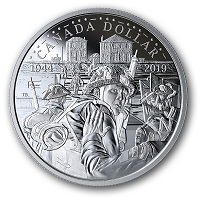
Face value: 25 dollars … Composition: 99.99% Pure Silver;
Finish: Proof; Weight: 23.17 g; Diameter: 36.07 mm;
Edge: Serrated; Mintage: 20,000; Artist: Tony Bianco;
Packaging: Maroon clamshell with black beauty box.
They came by sea. Their target: Juno Beach. On June 6, 1944, about 14,000 Canadians stormed the beaches of Normandy as the Allies launched Operation Overlord. D-Day was the largest amphibious landing in history and the stakes were high: to gain a foothold in Fortress Europe, Allied troops had to break through a coastline fortified with mined obstacles, concrete pillboxes, machine-gun nests and heavy artillery batteries.
“They had trained for months, knowing that 3rd Canadian Infantry Division and 2nd Canadian Armoured Brigade would be assault troops on D-Day. But for the vast majority, this was their first battle ever, the first time they experienced an enemy fire. And one can only imagine with difficulty the fear—and the hope—they felt as their landing craft approached the far shore.” Dr. Stephen Harris, CD, PhD, Directorate of History and Heritage, Canadian Armed Forces. Your 2019 Proof Silver Dollar commemorates the 75th anniversary of D-Day by putting a human face on a historic event. Inspired by a real-life moment seen in the original film footage, a young soldier’s apprehension and a simple gesture remind us of the courage of those who carried the weight of history with them that day. In the face of danger and uncertainty, Canadians fought to come ashore at Saint-Aubin-sur-Mer, Bernières-sur-Mer, Courseulles-sur-Mer and Graye-sur-Mer, knowing that success on D-Day was just the beginning.
Design: Designed by Tony Bianco, your coin steps back in time to the morning of June 6, 1944, as the first wave of Canadian troops storms Juno Beach. The scene shares the same inspiration as the Juno Beach Centre Association’s D-Day anniversary logo; it re-creates a moment caught on film when the North Shore (New Brunswick) Regiment landed on Nan Red Beach (La Rive Plage). In the foreground, an infantry soldier has a strained expression on his face after surveying what lies ahead—this is his first real combat experience. A reassuring pat is a touching moment of humanity and a gesture of solidarity amid enemy fire and fear, while the wedding ring is a reminder of loved ones back home. In the sky above, a sequence of dots and dashes represent the letter V (for “Victory”) in Morse code; they allude to the radio broadcasts that announced the Allied landings that day. The reverse includes the word “CANADA”, the double dates “1944” and “2019”, and the face value “DOLLAR”. The obverse features the effigy of Her Majesty Queen Elizabeth II by Susanna Blunt.
Did you know…
It was one of the most carefully prepared operations of the war … All forces (air, ground and naval) underwent intensive training to eliminate potential communication or logistic issues. By May 1944, troops, aircraft, ships, vehicles, supplies, and equipment had secretly amassed in southeast England. Prefabricated harbours known as Mulberries were built for unloading cargo and underwater pipelines (Pluto) were put into place to convey fuel and oil across the English Channel.
Code-name: Juno … Until the morning of June 5, troops only knew their landing destination by code name: Utah and Omaha Beaches (American forces) in the west; Gold Beach (British forces) and Sword Beach (British and French forces) in the east; and in the centre, Juno Beach (14,000 Canadian and 8,000 British forces).
The fleet … From battleships and destroyers to landing craft infantry (LCIs) and transport ships, nearly 7,000 Allied vessels took part in the assault phase known as Operation Neptune.
Weather was a key factor … The landings were originally scheduled for June 5, 1944, when a full moon would help illuminate the enemy’s defenses. But a storm front moved in on June 4 and the landings were postponed. The weather improved on June 5, but it wasn’t ideal either: many of the troops got seasick during the rough Channel crossing.
Morse signal … “V” for Victory (or “victoire”) began as a symbol of defiance and resistance in Occupied Belgium, and it quickly spread to other countries. BBC radio broadcasts transmitted the letter V in Morse code, with a “dot dot dot dash” sequence that resembled the opening notes of Beethoven’s famous Fifth Symphony.


Roncesvalles Polish Festival
https://polishfestival.ca www.kazimierz.org
www.troyakclub.com
The 2019 Roncesvalles Polish Festival, North America’s largest celebration of Polish culture in Toronto’s best neighbourhood, Roncesvalles Village! will be taking place on September 14th and 15th, 2019. Now entering its fourteenth year, the Festival adds an old-world charm to today’s Roncesvalles Village, well-known as one of Toronto’s most vibrant, diverse and creative communities. Enjoy great local and international music, including Polish folklore, Polka and Euro dance bands, and entertainment from near and far on multiple stages. Saturday night enjoy the ever-popular Disco Polo Party. Come out and sample fantastic cuisine from over 40 renowned restaurants, cafes, bakeries, and bistros, along Roncesvalles, and of course, lots of traditional Polish fare, including pierogi, kielbasa, bigos, cabbage rolls, and much much more!

Saturday, September 14th, 2019 … Festival Hours: 11:00am to 11:00pm
Sunday, September 15th, 2019 … Festival Hours: 11:00am to 7:00pm
Discover treasures along the 18 blocks of boutique shops and merchants. We also have a Car Show and many great vendors with unique products and food. The Roncesvalles Polish Festival is easy to get to by transit and car, family-friendly and free, with lots of entertainment for kids, families, and adults, including two midway areas, three stages with continuous entertainment, two giant beverage gardens, and of course the wonderful offerings of Roncesvalles Village’s restaurants and merchants. Find out what over 300,000 people discovered last year: nobody knows how to party quite like us! See you at the Roncesvalles Polish Festival!


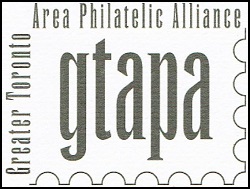
www.gtapa.org
The GTAPA is committed to promote and stimulate the art of philately
to all ages for fun, culture, education, and friendship.


Royal *2019* Royale
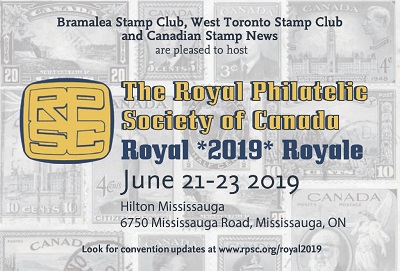
The West Toronto Stamp Club, Bramalea Stamp Club, and Canadian Stamp News are co-hosting Royal *2019* Royale. The June 21-23 convention will be held at the classy Hilton Mississauga on 6750 Mississauga Road. The next annual general meeting (AGM) of The Royal Philatelic Society of Canada (RPSC) will be held on the morning of June 22 during the society’s 91st convention in Mississauga, Ontario. The aim of the AGM, which will be held at the Hilton Mississauga/Meadowvale, is for members to receive and consider reports from executive members, directors and duty officers as well as the society’s financial statements as of Dec. 31. Members will also consider – and if approved, ratify, sanction and confirm – all by-laws, contracts, acts, and proceedings of The RPSC’s board of directors enacted since the last AGM. There will also be an election of seven directors. The 2019 election of director positions will be decided by secret ballots submitted by members of the society.

